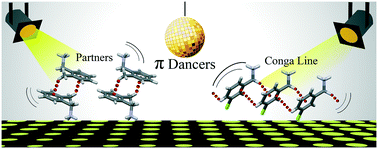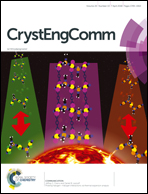π-Choreography in aromatic ammonium formate solids†
Abstract
π-Interactions are a crucial factor in how aromatic ring systems are arranged and organized in the solid state. While these interactions are typically referred to as “π–π stacking interactions”, in reality, π–π stacking (direct overlap of rings) is a special case of interaction that is relatively uncommon, and is reserved for specifically tuned rings, typically those polarized by their substituents. More typically, a variety of other interactions involving the π-system of the aromatic rings exist in the solid state. These include the common offset (or “slipped”) π-interaction (really C–H⋯π) and C–H⋯π T-shaped arrangements. We have chosen an experimental approach to determine the likelihood of encountering π-interactions in two sets of layered salts. In both cases, benzylamines are used for the cations; however, the anion in one case is formate, and in the other is the mono-anion of pyrazoledicarboxylic acid (HPzDCA). To investigate and analyze the π-interactions found in each case, we report on eight new benzylammonium formate lamellar structures. These weak interactions are then compared to similar structures found in the Cambridge Structural Database, and to the HPzDCA case. This represents an analysis of the natural organization and directing of molecules containing aryl moieties when given the chance to self-assemble.



 Please wait while we load your content...
Please wait while we load your content...